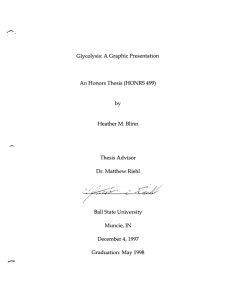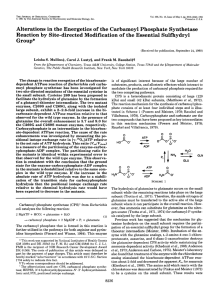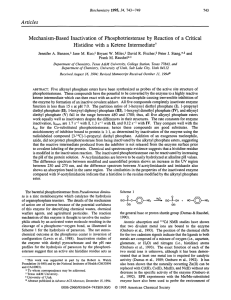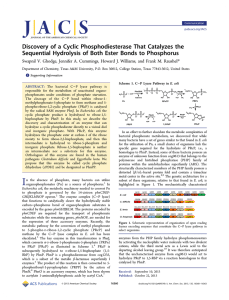Ch. 8 notes
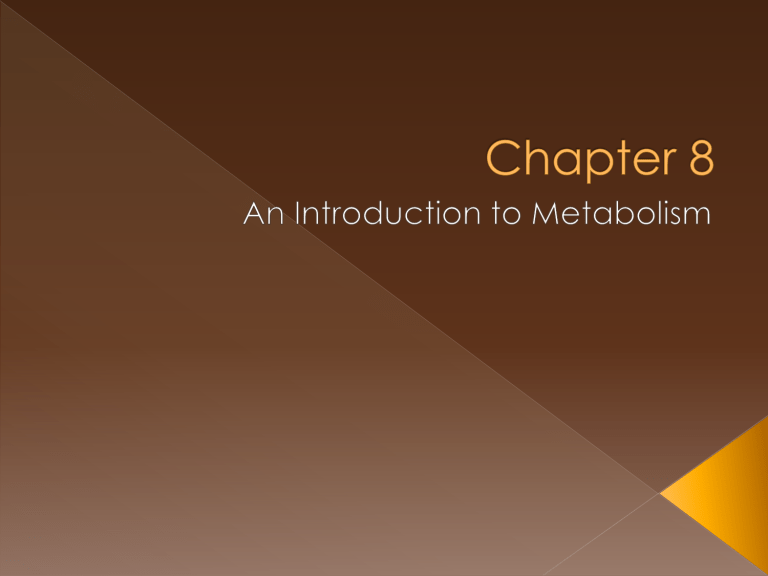
The totality of an organism’s chemical reactions http://chemistry.elmhurst.edu/vchembo ok/610citricac.html
https://s-media-cacheak0.pinimg.com/736x/ef/7b/51/ef7b512 df0a5ce651dbbeea3300202d5.jpg
Anabolic and catabolic
Which reactions release energy?
Which reactions consume energy?
Which reactions break down molecules?
Which reactions build up larger molecules?
Which reactions are considered “uphill”?
What type of reaction is photosynthesis?
What type of reaction is cellular respiration?
Contrast kinetic energy with potential energy.
Which type of energy does water behind a dam have? A mole of glucose?
http://upload.wikimedia.org/wikipedia/co mmons/thumb/5/57/Hydroelectric_dam.svg
/1280px-Hydroelectric_dam.svg.png
http://phet.colorado.edu/en/simulation/en ergy-skate-park http://thumbs.dreamstime.com/z/glucosemolecule-11063520.jpg
What is free energy? What is its symbol?
›
›
Endothermic - absorbs heat, H > 0
Exothermic - releases heat,H < 0
Reactions can also be classified according to the change in the free energy of the reaction:
›
›
Endergonic - NON-SPONTANEOUS, G > 0
Exergonic - SPONTANEOUS, G < 0
Is cellular respiration an endergonic or an exergonic reaction? What is ∆G for this reaction?
Is photosynthesis endergonic or exergonic? What is the energy source that drives it?
List the three main kinds of work that a cell does. Give an example of each.
1. Chemical work
2. Transport work
3. Mechanical work
W
Which bond is likely to break?
By what process will that bond break?
When the terminal phosphate is broken, a molecule of inorganic phosphate Pi is formed, and energy is ___________?
For this reaction ATP ADP + Pi, ∆G = ?
What is energy coupling? See Fig. 8.10
In many cellular reactions, a phosphate group is transferred from ATP to some other molecule in order to make the second molecule less stable. The second molecule is said to be
____________.
http://www.indiana.edu/~oso/animation s/SN2%2BE.html
What is a catalyst?
What is activation energy? See Fig. 8.14
What effect does an enzyme have on
E
A
?
Is ∆G positive or negative?
How is ∆G affected by the enzyme?
http://bio1151.nicerweb.com/Locked/m edia/ch08/08_17CatalyticCycle.jpg
What is meant by induced fit?
Explain how protein structure is involved in enzyme specificity.
Enzymes use a variety of mechanisms to lower activation energy. Describe four of these mechanisms.
1. acting as a template for substrate orientation
2. stressing the substrates and stabilizing the transition state
3. providing a favorable microenvironment
4. participating directly in the catalytic reaction
Many factors can affect the rate of enzyme action. Explain each factor listed below.
A. Initial concentration of substrate
B. pH
C. Temperature
Why can extremes of pH or very high temperatures affect enzyme activity?
Name a human enzyme that functions well in pH 2. Where is it found?
Distinguish between cofactors and coenzymes. Give examples of each.
Compare and contrast competitive inhibitors and noncompetitive inhibitors. http://bcs.whfreeman.com/thelifewire/c ontent/chp06/0602001.html



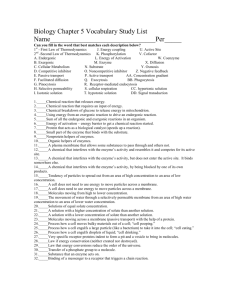
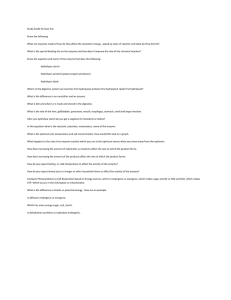

![metabolism%20worksheet[1].doc](http://s2.studylib.net/store/data/015294840_1-1cfaa5b6a1aee37b3942166632a431e9-300x300.png)
